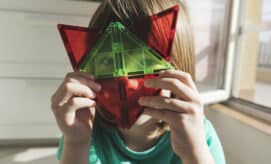Preschoolers are often fascinated by the vehicles they see on the road, with their different sizes, colors, sounds, and uses. Whether it’s a bus stopping to pick up passengers, a large dump truck carrying a load of dirt, or a firetruck zooming by, children are eager to know what the vehicle is doing and where it’s going. In this article, we share a variety of play-based learning activities and popular children’s books that support early developmental skills by building on little learners’ curiosity about cars and trucks.
Car & Truck-themed Learning Activities for Preschoolers
Easy-to-Create Vehicle-themed Sensory Experiences
A fun way to learn about cars and trucks is with sensory bins! Young children can explore a variety of colors, shapes, and textures as they explore with cars in bins filled with sand, mud, and water. These bins are especially fun for toddlers and young preschoolers, who enjoy sensory experiences that encourage tactile exploration. An important additional benefit is that manipulating and moving play cars and trucks through textured material offers little ones an opportunity to use the fine muscles and motor skills in their fingers and hands that will help them hold pencils as they start to practice writing. A few ideas for car and truck-themed sensory bins are included below.
- Car wash: To set up a sensory bin car wash, simply fill a large plastic tub with play cars, water, and a small amount of dish soap! You might consider adding sponges or toothbrushes for little ones to use to clean the cars.
- Construction zone: A construction zone bin is a fun way for young children to explore different kinds of trucks. To set up the bin, fill a plastic tub with dried beans (if you don’t have those available, you can use whatever material you have on hand, like sand, dried rice/pasta, or even shredded paper), and place play construction trucks in the material. As the children move the trucks around the bin, you might talk with them about the different kinds of construction vehicles and the unique roles each one has on a construction site.
- Monster truck sensory bin: Little ones are often fascinated by the large size of monster trucks and the loud noises that monster trucks make! You can create a monster truck sensory bin by placing mud in a plastic bin, and then adding in recycled materials such as egg cartons, toilet paper rolls, and empty food containers to form an obstacle course. You might also include some rocks or pretend cones for the cars to navigate around.
Outdoor Play & Learning with Cars and Trucks
The sandbox is a great place for children to build roads or create construction sites for their cars and trucks. This type of open-ended play experience encourages creative thinking, collaboration, and self-expression.
Forming roads with sand, and pushing play cars through the sand builds hand muscles needed for fine motor skills. Sandbox play is also a great whole-body sensory experience, as young children can sit in the sand, feeling the texture with not just their hands, but also their arms, legs, and feet.
Children can use any part of your outdoor play space to create environments for playing with cars and trucks. You might offer children materials they can use, such as blocks, small toys, recycled toilet paper rolls, and natural materials like rocks, dirt, and twigs.
Process Art with Toy Cars









